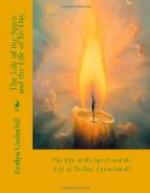A secondary cause of such world refusal is the first awakening of the contemplative powers; the intuition of Eternity, hitherto dormant, and felt at this stage to be—in its overwhelming reality and appeal—in conflict with the unreal world and unsublimated active life. This is the controlling idea of the hermit and recluse. It is well seen in St. Teresa; whom her biographers describe as torn, for years, between the interests of human intercourse and the imperative inner voice urging her to solitary self-discipline and prayer. So we may say that in the beginning of the life of the Spirit, as history shows it to us, if disillusion marks the first moment, some measure of asceticism, of world-refusal and painful self-schooling, is likely to mark the second moment.
What we are watching is the complete reconstruction of personality; a personality that has generally grown into the wrong shape. This is likely to be a hard and painful business; and indeed history assures us that it is, and further that the spiritual life is never achieved by taking the line of least resistance and basking in the divine light. With world-refusal, then, is intimately connected stern moral conflict; often lasting for years, and having as its object the conquest of selfhood in all its insidious forms. “Take one step out of yourself,” say the S[=u]fis, “and you will arrive at God."[57] This one step is the most difficult act of life; yet urged by love, man has taken it again and again. This phase is so familiar to every reader of spiritual biography, that I need not insist upon it. “In the field of this body,” says Kabir, “a great war goes forward, against passion, anger, pride and greed. It is in the Kingdom of Truth, Contentment and Purity that this battle is raging, and the sword that rings forth most loudly is the sword of His Name."[58] “Man,” says Boehme, “must here be at war with himself if he wishes to be a heavenly citizen ... fighting must be the watchword, not with tongue and sword, but with mind and spirit; and not to give over."[59] The need of such a conflict, shown to us in history, is explained on human levels by psychology. On spiritual levels it is made plain to all whose hearts are touched by the love of God. By this way all must pass who achieve the life of the Spirit; subduing to its purposes their wayward wills, and sublimating in its power their conflicting animal impulses. This long effort brings, as its reward a unification of character, an inflow of power: from it we see the mature man or woman of the Spirit emerge. In St. Catherine of Genoa this conflict lasted for four years, after which the thought of sin ceased to rule her consciousness.[60] St. Teresa’s intermittent struggles are said to have continued for thirty years. John Wesley, always deeply religious, did not attain the inner stability he calls assurance till he was thirty-five years old. Blake was for twenty years in mental conflict, shut off from the sources of his spiritual life. So slowly do great personalities come to their full stature, and subdue their vigorous impulses to the one ruling idea.




